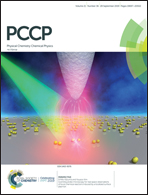Application of a bipolar nanopore as a sensor: rectification as an additional device function
Abstract
We model and simulate a nanopore sensor that selectively binds analyte ions. This binding leads to the modulation of the local concentrations of the ions of the background electrolyte (KCl), and, thus, to the modulation of the ionic current flowing through the pore. The nanopore's wall has a bipolar charge pattern with a larger positive buffer region determining the anions as the main charge carriers and a smaller negative binding region containing binding sites. This charge pattern proved to be an appropriate one as shown by a previous comparative study of varying charge patterns (Mádai et al. J. Mol. Liq., 2019, 283, 391–398.). Binding of the positive analyte ions attracts more anions in the pore thus increasing the current. The asymmetric nature of the pore results in an additional device function, rectification. Our model, therefore, is a dual response device. Using a reduced model of the nanopore studied by a hybrid computer simulation method (Local Equilibrium Monte Carlo coupled with the Nernst–Planck equation) we show that we can create a sensor whose underlying mechanisms are based on the changes in the local electric field as a response to changing thermodynamic conditions. The change in the electric field results in changes in the local ionic concentrations (depletion zones), and, thus, changes in ionic currents.

- This article is part of the themed collection: 2019 PCCP HOT Articles


 Please wait while we load your content...
Please wait while we load your content...